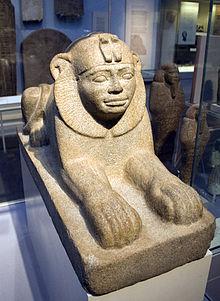
Description
The Sphinx of King Taharqo is a statue with a lion’s body and a man’s head, created from myths and legends. The sphinx was built around roughly 680 BCE by the Kushites. It was discovered at Kawa, northern Sudan, in the Temple of Amun, where Francis Llewellyn Griffith excavated it in 1932, and it now resides at the British Museum (Crabben 2022). The sphinx is a granite statue, most probably the granite gneiss, which is sandy grey. Granite, using which the Sphinx of King Taharqo was sculpted, was mined from granite quarries at Tombos. Compared to the sphinx at Giza, it is minimal, about a size of a spaniel, with a height of 40.6cm and a width of 73cm. It is famous for its projection of both Egyptian and Kushite elements.
The lion part of the statue is done in a typical Egyptian style, like the grand sphinx itself. Tace of the artifact is the Sudanese resemblance of the Tahsrqo, the black king, the fourth pharaoh to rule over the combined kingdoms of Kush and Egypt. Many sculptures found from this early Kushite period, such as this sphinx, are characterized by a realism appeal which often does little to flatter the individual portrayed. The form of the lion’s mane and his ears closely resemble elements found on Ancient Egyptian sphinxes as far back as the 12th Dynasty, which is about a thousand years before. The Sphinx of Taharqo wears a skull cap, double-uraeus, and a cartouche on the breast. The sphinx is decorated with engraved designs, and a rosette occupies the base. There are hieroglyphics and symbols on the artifact that make clear that it is a genuine and legitimate portrait of the great King Taharqo.
Cultural and Historical Importance of the Piece
For many years, Egypt was in control and would harass the Kushites. They would take precious metals such as gold from the Kushites and anything else they needed. However, power and control changed around 730 BC, when the Kushites took control of Egypt and established a rival in religion, architecture, and art practices. King Tahraqu absorbed and adopted Egyptian customs rather than pushing Kushites’ customs on them. Taharqo worshipped the Egyptian God Amun and built pyramids on the Egyptian Model (“Sphinx of Taharqo” 2022). The sphinx, as a whole, represents the fusion of the Egyptian and the Kushite culture during the shift of power. By adapting to the Egyptian culture, King Taharqo had an easier time keeping control and strengthening the political power of the large new kingdom. Having the face of Taharqo on the sphinx is a symbol of a new national identity.
Taharqo ordered the creation of a sphinx with his image and declared it would remain in the recently restored Temple of Amun. Because only rulers and priests were allowed into the temple, only people in positions of authority could see the sphinx sculpture. When Kushites encountered it in an inner sanctuary, its black African traits would have comforted them, while its distinctively Egyptian iconography would have made Egyptians feel well at home. Although the statue has a few Egyptian features and characteristics, it is a statement of the Kushite’s authority and power. The Egyptians used sphinx to symbolize power and wealth, and by creating their own, Kushites showed power not only on their own but also the morph of both cultures.
References
Crabben, Jan van der. 2022.”Taharqa Sphinx.” World History Encyclopedia. World history organization, Web.
“Sphinx of Taharqo” 2022. 100 Objects British Museum. Web.